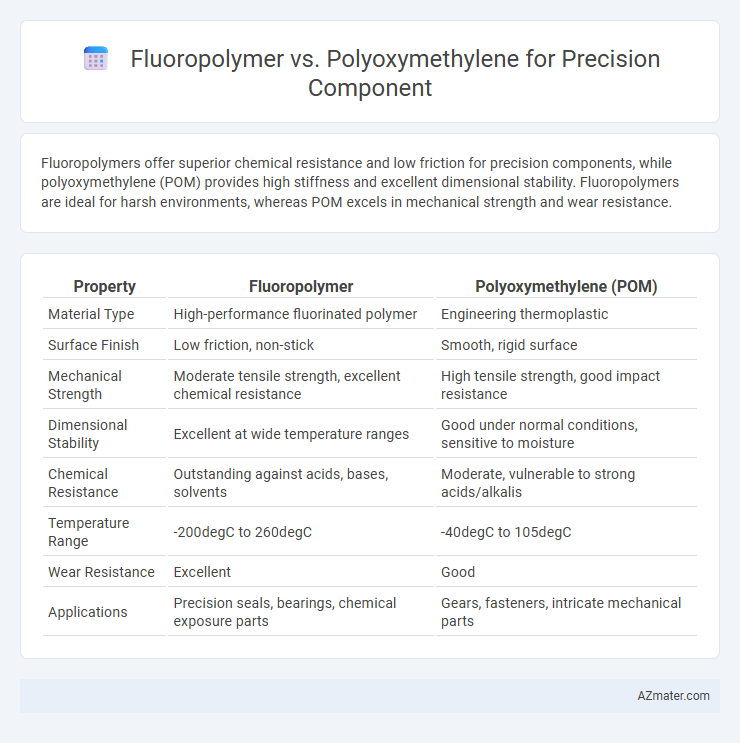Fluoropolymers offer superior chemical resistance and low friction for precision components, while polyoxymethylene (POM) provides high stiffness and excellent dimensional stability. Fluoropolymers are ideal for harsh environments, whereas POM excels in mechanical strength and wear resistance.
Table of Comparison
| Property | Fluoropolymer | Polyoxymethylene (POM) |
|---|---|---|
| Material Type | High-performance fluorinated polymer | Engineering thermoplastic |
| Surface Finish | Low friction, non-stick | Smooth, rigid surface |
| Mechanical Strength | Moderate tensile strength, excellent chemical resistance | High tensile strength, good impact resistance |
| Dimensional Stability | Excellent at wide temperature ranges | Good under normal conditions, sensitive to moisture |
| Chemical Resistance | Outstanding against acids, bases, solvents | Moderate, vulnerable to strong acids/alkalis |
| Temperature Range | -200degC to 260degC | -40degC to 105degC |
| Wear Resistance | Excellent | Good |
| Applications | Precision seals, bearings, chemical exposure parts | Gears, fasteners, intricate mechanical parts |
Introduction to Fluoropolymer and Polyoxymethylene
Fluoropolymers, known for their exceptional chemical resistance, low friction, and high thermal stability, are widely used in precision components where durability and reliability under harsh conditions are critical. Polyoxymethylene (POM), or acetal, offers high stiffness, excellent dimensional stability, and low moisture absorption, making it ideal for precision mechanical parts requiring tight tolerances and smooth operation. Comparing these materials highlights fluoropolymers' superior chemical inertness against POM's mechanical strength and machinability in precision engineering applications.
Material Composition and Structure
Fluoropolymers exhibit a molecular structure characterized by tightly bonded carbon-fluorine atoms, contributing to exceptional chemical resistance, low friction, and thermal stability, ideal for precision components exposed to harsh environments. Polyoxymethylene (POM), also known as acetal, features a linear polymer structure with repeating oxymethylene units, offering high stiffness, excellent dimensional stability, and low moisture absorption suitable for mechanically demanding precision parts. The distinct material compositions influence their performance, with fluoropolymers prioritizing chemical inertness and thermal endurance, while polyoxymethylene provides superior mechanical strength and precision in fabrication.
Mechanical Properties Comparison
Fluoropolymers exhibit superior chemical resistance and low friction coefficients compared to polyoxymethylene, making them ideal for precision components requiring wear resistance and thermal stability. Polyoxymethylene, however, offers higher tensile strength and stiffness, providing excellent dimensional stability and load-bearing capacity in mechanical applications. The choice between these materials depends on the specific demands for mechanical durability versus resistance to chemicals and temperature in precision component manufacturing.
Chemical Resistance: A Detailed Analysis
Fluoropolymers exhibit exceptional chemical resistance against a wide range of aggressive substances including acids, bases, and organic solvents, making them ideal for precision components exposed to harsh chemical environments. Polyoxymethylene (POM), while offering good resistance to solvents and mild chemicals, tends to degrade when exposed to strong acids or oxidizing agents. Selecting fluoropolymer materials ensures superior durability and longevity in chemically demanding applications, whereas POM is suitable for components where moderate chemical exposure is expected.
Dimensional Stability in Precision Applications
Fluoropolymers exhibit exceptional dimensional stability in precision components due to their low thermal expansion coefficients and chemical inertness, making them ideal for applications requiring tight tolerances and resistance to harsh environments. Polyoxymethylene (POM), while offering good mechanical strength and rigidity, may experience more dimensional variations under temperature fluctuations and moisture exposure, impacting precision in critical components. Selecting fluoropolymers over POM enhances long-term accuracy and reliability in precision applications where minimal dimensional change is crucial.
Temperature Performance and Tolerance
Fluoropolymers demonstrate superior temperature resistance, maintaining stability in continuous use up to 260degC, making them ideal for precision components exposed to high thermal stress. Polyoxymethylene (POM) tolerates temperatures up to approximately 120degC, offering excellent dimensional stability and low thermal expansion below this threshold. For applications demanding high temperature performance and tight tolerance, fluoropolymers provide enhanced thermal resilience while POM excels in mechanical precision under moderate heat conditions.
Wear and Friction Characteristics
Fluoropolymer materials, such as PTFE, exhibit exceptional low friction coefficients and excellent wear resistance, making them ideal for precision components requiring minimal wear and smooth operation. Polyoxymethylene (POM), known for its high stiffness and dimensional stability, offers moderate friction but can experience higher wear under abrasive conditions compared to fluoropolymers. Selecting between fluoropolymers and POM depends on the specific application's tolerance for frictional heat and mechanical load, with fluoropolymers favored for ultra-low friction environments and POM preferred where structural rigidity is critical.
Machinability and Processing Considerations
Fluoropolymer offers superior chemical resistance and low friction, making it ideal for precision components requiring high wear resistance; however, its machining is challenging due to low thermal conductivity and potential elastomeric deformation. Polyoxymethylene (POM) provides excellent dimensional stability and machinability with minimal tool wear, allowing for tight tolerances and complex geometries in precision manufacturing. Processing fluoropolymers demands specialized equipment and slower feed rates to avoid melting or deformation, whereas polyoxymethylene can be processed efficiently with standard machining tools, enhancing production scalability.
Cost Efficiency and Lifecycle Analysis
Fluoropolymers offer superior chemical resistance and thermal stability, resulting in longer lifecycle durability for precision components, though they come with higher initial material costs compared to Polyoxymethylene (POM). Polyoxymethylene provides excellent dimensional stability and low friction at a lower cost, making it a cost-efficient option for applications with less stringent environmental demands. Lifecycle analysis typically favors fluoropolymers in high-performance, corrosive environments due to reduced maintenance and replacement frequency, while POM is preferred for budget-sensitive projects requiring good mechanical properties.
Application Suitability in Precision Components
Fluoropolymers offer outstanding chemical resistance, low friction, and high thermal stability, making them ideal for precision components in harsh environments such as chemical processing and aerospace industries. Polyoxymethylene (POM) provides excellent dimensional stability, high mechanical strength, and low moisture absorption, which suits precision parts requiring tight tolerances and continuous mechanical stress like gears and bearings. Selecting between fluoropolymers and POM depends on the application's demand for chemical endurance versus mechanical performance and operating temperature range.

Infographic: Fluoropolymer vs Polyoxymethylene for Precision Component
 azmater.com
azmater.com